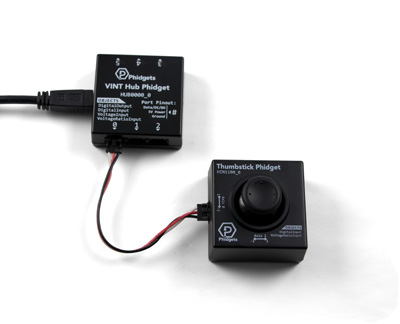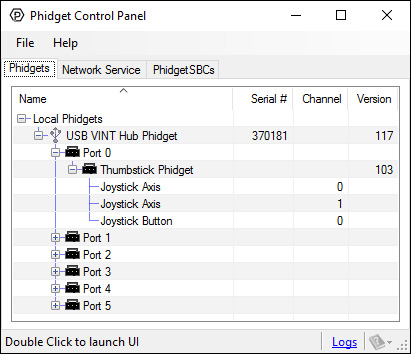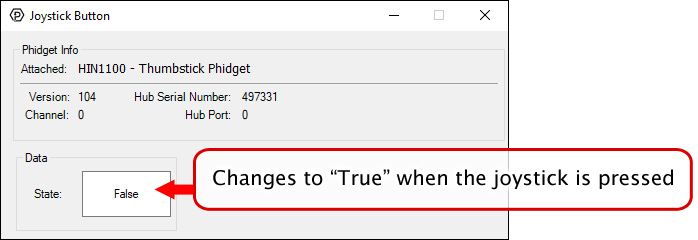HIN1100 User Guide: Difference between revisions
No edit summary |
No edit summary |
||
| Line 1: | Line 1: | ||
__NOINDEX__ | __NOINDEX__ | ||
__NOTOC__ | |||
<metadesc>The Thumbstick Phidget is perfect for making a custom controller for your project. Two-axis with a center pushbutton, it plugs into a VINT port.</metadesc> | <metadesc>The Thumbstick Phidget is perfect for making a custom controller for your project. Two-axis with a center pushbutton, it plugs into a VINT port.</metadesc> | ||
[[Category:UserGuide]] | [[Category:UserGuide]] | ||
== | ==Part 1: Setup== | ||
* [{{SERVER}}/products.php?product_id=HIN1100 HIN1100 Thumbstick Phidget] | * [{{SERVER}}/products.php?product_id=HIN1100 HIN1100 Thumbstick Phidget] | ||
| Line 17: | Line 18: | ||
{{UGIntroDone|HIN1100}}. | {{UGIntroDone|HIN1100}}. | ||
==Using | {{UGcontrolpanel|HIN1100}} | ||
== Part 2: Using Your Phidget == | |||
===About=== | |||
The 2-axis Thumbstick Phidget tracks the horizontal and vertical position of the stick between -1 and 1. The stick will snap back to the center when released. The thumbstick can also be clicked down to activate a push-button, similar to a video game controller. | |||
{{ | [[Image:HIN1100-About.jpg|link=]] | ||
===Explore Your Phidget Channels Using The Control Panel=== | |||
You can use your Control Panel to explore your Phidget's channels. | |||
'''1.''' Open your Control Panel, and you will find the following channels: | |||
[[Image:HIN1100_Panel.jpg|link=|center]] | |||
'''2.''' Double click on a channel to open an example program. | |||
{{UGC-Start}} | |||
{{ | {{UGC-Entry|Joystick Axis:| Reports the tilt of the joystick (Channel 0 for up/down and channel 1 for left/right)| | ||
In your Control Panel, double click on "Joystick Axis": | |||
[[Image:HIN1100-VoltageRatio.jpg|center|link=]]}} | |||
{{ | {{UGC-Entry|Joystick Button:| Reports the state of the pushbutton| | ||
In your Control Panel, double click on "Joystick Button": | |||
[[Image:HIN1100-DigitalInput.jpg|center|link=]]}} | |||
{{UGC-End}} | |||
{{UG-Part3}} | |||
== Part 4: Advanced Topics and Troubleshooting == | |||
{{UGC-Start}} | |||
{{UGC-Addressing}} | |||
{{UGC-DataInterval}} | |||
{{UGC-Entry|Converting to Polar Coordinates|| | |||
[[Image:HIN1100_Polar.jpg|700px|link=]] | [[Image:HIN1100_Polar.jpg|700px|link=]] | ||
| Line 41: | Line 65: | ||
::<math>\phi = atan2(x, y) </math> | ::<math>\phi = atan2(x, y) </math> | ||
Where | Where r is the magnitude, ϕ is the angle, and x and y are the two axis values. Atan2 is the 2-argument arctangent function, which you can find in most math libraries. For example, in C# you could use Math.Atan2(x,y). Depending on your language, ϕ may be in radians or degrees. | ||
Since x and y range from -1.0 to 1.0, the resulting r will range from -√2 to √2, so you may also want to modify the first formula like so: | |||
Since | |||
::<math>\text{r} = \frac{\sqrt{x^2 + y^2}}{\sqrt{2}} </math> | ::<math>\text{r} = \frac{\sqrt{x^2 + y^2}}{\sqrt{2}} </math> | ||
This way, your | This way, your r will range from 0 to 1, which is more intuitive than -√2 to √2. | ||
}} | |||
{{ | {{UGC-End}} | ||
Revision as of 21:04, 4 August 2020
Part 1: Setup
- HIN1100 Thumbstick Phidget
- USB cable and computer
- Phidget Cable
- VINT Hub
Next, you will need to connect the pieces:

- Connect the VINT Hub to your computer with a USB cable.
- Connect the HIN1100 to the VINT Hub using the Phidget Cable.
Now that you have everything together, let's start using the HIN1100!.
Phidget Control Panel
In order to demonstrate the functionality of the HIN1100, the Phidget Control Panel running on a Windows machine will be used.
The Phidget Control Panel is available for use on both macOS and Windows machines.
Windows
To open the Phidget Control Panel on Windows, find the ![]() icon in the taskbar. If it is not there, open up the start menu and search for Phidget Control Panel
icon in the taskbar. If it is not there, open up the start menu and search for Phidget Control Panel
macOS
To open the Phidget Control Panel on macOS, open Finder and navigate to the Phidget Control Panel in the Applications list. Double click on the ![]() icon to bring up the Phidget Control Panel.
icon to bring up the Phidget Control Panel.
For more information, take a look at the getting started guide for your operating system:
Linux users can follow the getting started with Linux guide and continue reading here for more information about the HIN1100.
First Look
After plugging the HIN1100 into your computer and opening the Phidget Control Panel, you will see something like this:

The Phidget Control Panel will list all connected Phidgets and associated objects, as well as the following information:
- Serial number: allows you to differentiate between similar Phidgets.
- Channel: allows you to differentiate between similar objects on a Phidget.
- Version number: corresponds to the firmware version your Phidget is running. If your Phidget is listed in red, your firmware is out of date. Update the firmware by double-clicking the entry.
The Phidget Control Panel can also be used to test your device. Double-clicking on an object will open an example.
Part 2: Using Your Phidget
About
The 2-axis Thumbstick Phidget tracks the horizontal and vertical position of the stick between -1 and 1. The stick will snap back to the center when released. The thumbstick can also be clicked down to activate a push-button, similar to a video game controller.

Explore Your Phidget Channels Using The Control Panel
You can use your Control Panel to explore your Phidget's channels.
1. Open your Control Panel, and you will find the following channels:

2. Double click on a channel to open an example program.
In your Control Panel, double click on "Joystick Axis":

In your Control Panel, double click on "Joystick Button":

Part 3: Create your Program
Part 4: Advanced Topics and Troubleshooting
Before you open a Phidget channel in your program, you can set these properties to specify which channel to open. You can find this information through the Control Panel.
1. Open the Control Panel and double-click on the red map pin icon:

2. The Addressing Information window will open. Here you will find all the information you need to address your Phidget in your program.

See the Phidget22 API for your language to determine exact syntax for each property.
The Change Trigger is the minimum change in the sensor data needed to trigger a new data event.
The Data Interval is the time (in ms) between data events sent out from your Phidget.
The Data Rate is the reciprocal of Data Interval (measured in Hz), and setting it will set the reciprocal value for Data Interval and vice-versa.
You can modify one or both of these values to achieve different data outputs. You can learn more about these properties here.

For some applications, you may want to convert the 2-axis data of the Thumbstick Phidget into an angle and magnitude. This can be helpful if you want to use it like a video game controller. You can use the following formulas:
Where r is the magnitude, ϕ is the angle, and x and y are the two axis values. Atan2 is the 2-argument arctangent function, which you can find in most math libraries. For example, in C# you could use Math.Atan2(x,y). Depending on your language, ϕ may be in radians or degrees. Since x and y range from -1.0 to 1.0, the resulting r will range from -√2 to √2, so you may also want to modify the first formula like so:
This way, your r will range from 0 to 1, which is more intuitive than -√2 to √2.



